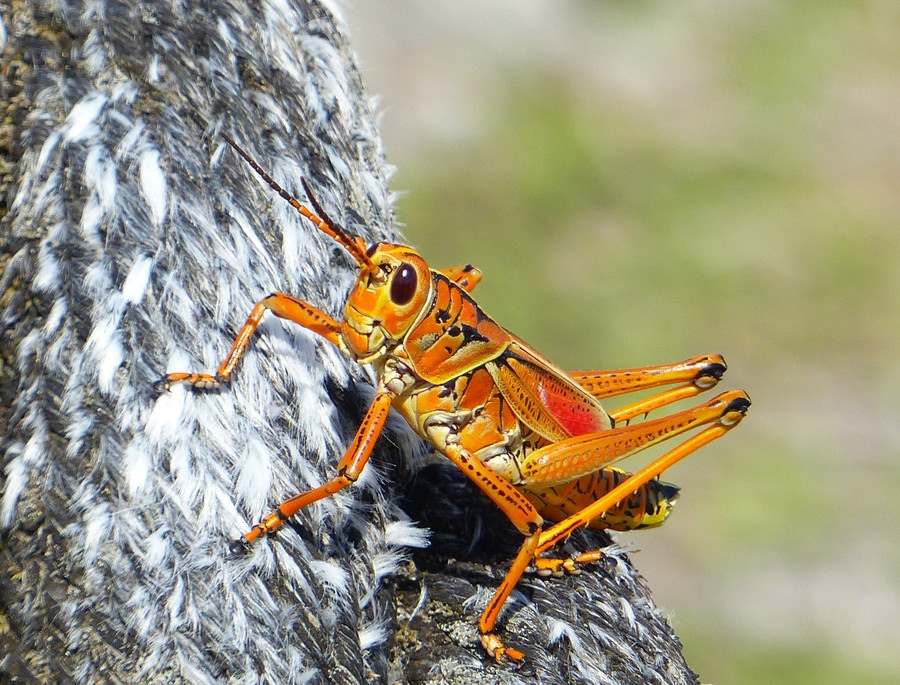Grasshoppers and crickets? Not the same thing
In childhood, summer days stretched out in endless, glorious hours, and one of our favorite activities was to catch grasshoppers.
While most insects do not make the cut, certain ones seemed cute and could be incorporated into our play.
To catch a grasshopper, you just needed a good eye and quick reflexes. All you had to do was track their trajectory, get to their landing area fast, and cup your hands over them before they took off again. The joy was in the effort, and then you immediately released them and did it all over again.
On our recent trip south, our final destination was the Everglades, an almost mythical swamp that stretches over large swathes of southern Florida. There are three types of terrain in the Everglades: mangrove swamps, grasslands, and bald cypress swamps.
We joined a swamp buggy tour — essentially a bus on huge tires — that took us through grasslands and bald cypress swamps.
The best part about traveling in May is that the weather is warm and there are still no crowds. Therefore, I had no trouble securing a seat by an open window. While the swamp apparently teems with assorted wildlife, all we saw were white-tailed deer, including some adorable fawns, and a manatee that was so busy cooling off in a channel that we saw nothing but the top of its head.
However, as I’m hanging through the open window, I see a multitude of highly colored small somethings in motion all along the grassy path. When I inquired about them, what I thought I heard through the roar of the engine was “lover” grasshopper, which sounded highly improbable. It turned out that this richly colored insect in tones of yellow, orange and black was the eastern lubber grasshopper, or Romalea microptera.
As per usual when discussing the natural world, nothing is straightforward and a few terms need to be considered. I have always used “grasshopper” and “cricket” as interchangeable terms. Unfortunately, that is not correct. “Locust” and “grasshopper” are more correctly interchangeable terms, with grasshoppers being a solitary insect while locusts are basically certain grasshoppers species gone wild.
Those benign grasshoppers who can convert to destructive locusts undergo this behavioral change when population explosions lead to excessive crowding. Under those conditions, when one grasshopper touches the hind wing of another, it causes an increase in serotonin production in the brain. This hormone changes the grasshopper behavior into swarming locusts, which go on eating frenzies that can devastate entire countries causing severe famines.
Fortunately only about 10 of the 8,000 grasshopper species can swarm.
And finally there is an insect called “katydid” that gets lumped in with the others.
All of these insects belong to the order orthoptera, meaning straight wings from the Greek ortho — straight or rigid referring to the front wing — and ptera, winged. The sub-order caelifera includes the grasshoppers (which have short antennae) and the sub-order ensifera contains the crickets and katydids (having longer antennae that are minimally the length of the insect’s body).
Some other distinguishing characteristics between grasshoppers and crickets are that crickets come out at dusk while grasshoppers are active during the day. Grasshoppers eat grass while crickets will eat animal matter.
To distinguish a katydid from a grasshopper, note that the body of the katydid is rounder and closely resembles a leaf, even having leaf-like veins on the body. They, likewise, eat animal matter. There are numerous other structural differences, but most of us will not inspect an insect in our hands long enough to examine it very closely.
The eastern lubber grasshopper is found from North Carolina to Florida, and westward all the way to Texas. They can be found in open pine woods, weedy fields and roadside vegetation, which explains my sighting. They lay their eggs in the ground after summer mating. The eggs overwinter and hatch in the spring warmth.
Grasshoppers develop into adults by a process called incomplete metamorphosis. This means that the although the juvenile, which looks like a miniature adult, will molt and shed its thin exoskeleton as it grows like other insects, it never forms a cocoon from which a physically different adult will emerge. There are five molts total at 15-day intervals.
Unfortunately, their preferred foods include foliage of citrus trees, vegetables and ornamental plants.
While the lubbers do not swarm, they are a problem in agricultural areas. Control methods include clearing away woody debris, turning over the soil where they lay eggs, pesticides when the eggs hatch, and there is even a fungus used on locusts — metarhzium — that can be useful.
All that glitters is not gold!






